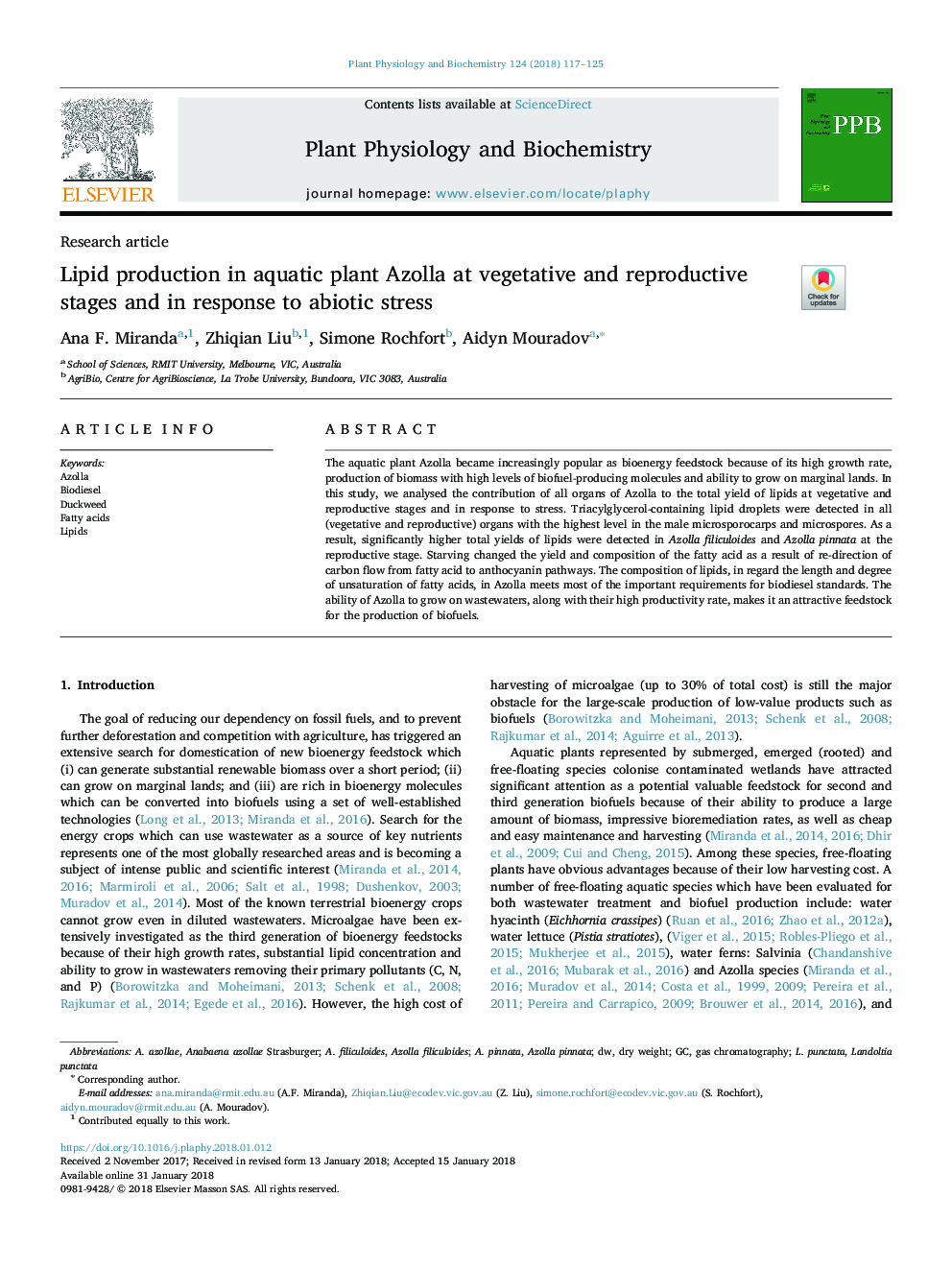| کد مقاله | کد نشریه | سال انتشار | مقاله انگلیسی | نسخه تمام متن |
|---|---|---|---|---|
| 8353321 | 1541897 | 2018 | 9 صفحه PDF | دانلود رایگان |
عنوان انگلیسی مقاله ISI
Lipid production in aquatic plant Azolla at vegetative and reproductive stages and in response to abiotic stress
ترجمه فارسی عنوان
تولید لیپید در گیاه آبزی آزولا در مراحل رویشی و زایشی و در پاسخ به استرس آبیوتیک
دانلود مقاله + سفارش ترجمه
دانلود مقاله ISI انگلیسی
رایگان برای ایرانیان
کلمات کلیدی
ترجمه چکیده
گیاه آبزی آزولا به دلیل رشد سریع آن، تولید زیست توده با سطوح بالای مولکول های تولید سوخت زیستی و توانایی رشد در سرزمین های حاشیه ای به عنوان ماده اولیه زیست انرژی تبدیل شده است. در این مطالعه، سهم تمام اعضای آزولا را در کل عملکرد لیپید ها در مراحل رشد و باروری و در پاسخ به استرس مورد تجزیه و تحلیل قرار دادیم. قطرات چربی حاوی تری آلفل گلیسرول در تمام اندام های روغنی و تناوبی با بالاترین سطح در میکروسپوراکارپ ها و میکروسپورهای مردی تشخیص داده شد. در نتیجه، میزان تولید کل لیپید ها به طور قابل ملاحظه ای بیشتر در آزولا فیلیکولئیدز و آزولا پیناتا در مرحله تولید مثل تشخیص داده شد. گرسنگی عملکرد و ترکیب اسید چرب را در نتیجه تغییر مسیر جریان کربن اسید چرب به مسیر آنتوسیانین تغییر داد. ترکیب لیپیدها در رابطه با طول و درجه عدم اشباع اسیدهای چرب در آزولا بیشترین الزامات مهم برای استانداردهای بیودیزل را برآورده می کند. توانایی آزولا برای رشد در فاضلاب همراه با میزان بالای بهره وری آن، یک منبع جذاب برای تولید سوخت های زیستی است.
موضوعات مرتبط
علوم زیستی و بیوفناوری
علوم کشاورزی و بیولوژیک
دانش گیاه شناسی
چکیده انگلیسی
The aquatic plant Azolla became increasingly popular as bioenergy feedstock because of its high growth rate, production of biomass with high levels of biofuel-producing molecules and ability to grow on marginal lands. In this study, we analysed the contribution of all organs of Azolla to the total yield of lipids at vegetative and reproductive stages and in response to stress. Triacylglycerol-containing lipid droplets were detected in all (vegetative and reproductive) organs with the highest level in the male microsporocarps and microspores. As a result, significantly higher total yields of lipids were detected in Azolla filiculoides and Azolla pinnata at the reproductive stage. Starving changed the yield and composition of the fatty acid as a result of re-direction of carbon flow from fatty acid to anthocyanin pathways. The composition of lipids, in regard the length and degree of unsaturation of fatty acids, in Azolla meets most of the important requirements for biodiesel standards. The ability of Azolla to grow on wastewaters, along with their high productivity rate, makes it an attractive feedstock for the production of biofuels.
ناشر
Database: Elsevier - ScienceDirect (ساینس دایرکت)
Journal: Plant Physiology and Biochemistry - Volume 124, March 2018, Pages 117-125
Journal: Plant Physiology and Biochemistry - Volume 124, March 2018, Pages 117-125
نویسندگان
Ana F. Miranda, Zhiqian Liu, Simone Rochfort, Aidyn Mouradov,
